We spent Monday and Tuesday in the mountains, in Zao Onsen, Yamagata and Yamadera. We walked a ridge 4,000 feet above sea level in serious weather, which wasn't much fun, then spent hours in a hot sulphur spring, which was. We stayed in a beautiful Ryokan.
The Autumn foliage was spectacular:
.jpg)
.jpg)
.jpg)
.jpg)
Wednesday, October 24, 2007
Up in the mountains
Posted by
Auntie Em
at
12:44 PM
0
comments
![]()
Labels: oba em no tabi
Sunday, October 21, 2007
Matsushima Ah! Matsushima! [1]
Whilst I wasn't moved to Haiku [1], Matsushima, even on a cloudy day, has an undeniable beauty. More than 300 islands litter Matsushima bay like fallen leaves.
We arrived by boat, sailing from Hon Shiogama. Hon Shiogama is an industrial town, with a fairly busy port:
We soon left this behind though, as the ferry threaded its way through the islands:.jpg)
Several of the islands can be reached by bridge. From here there are some striking views of the bay..jpg)
The autumn foliage is beginning to reflect the colours of the lacquerware bridge:.jpg)
On the largest of the islands stands a small temple:.jpg)
Hundreds of Daruma dolls have been placed in alcoves. These dolls represent Bodhidharma and are sold "eyeless". One makes a wish or pledges some action and colours in one of the eyes. Once the wish is accomplished or the action completed, the other eye is filled in. Each doll seemed to have both eyes, which is heartening:.jpg)
At dusk we went to Date Tadamune's Tea house, the Kanren-tei, for o-matcha and some ceremonial bowing. The tea house was used by the Date clan as a place to view the bay from the 1600s. One of the rooms is walled with gold, lacquered screens (described here), and the other has a free standing screen made up of four paintings over gold leaf. I don't know what these are like on a bright day, but as the light falls, the rooms are lit by lamps and the effect is nothing short of magical. I have been reading Junichiro Tanazaki's essay "In Praise of Shadows", and he describes the effect beautifully:
"Lacquerware decorated in gold is not something to be seen in a brilliant light... The sheen of the lacquer, set out in the night, reflects the wavering candlelight, announcing the drafts that find their way from time to time into the quiet room, luring one into a state of reverie... The thin, impalpable faltering light, picked up as though little rivers were running through the room, collecting little pools here and there, lacquers a pattern on the surface of the night itself."
(trans. Harper and Seidensticker)
No photograph could do that justice, I'm afraid, so I can't show you what I saw. But I sat there drinking in the rivers of light as best I could. I felt as though they peacefully illuminated me all the way home.
[1] See here
Posted by
Auntie Em
at
10:01 AM
0
comments
![]()
Labels: oba em no tabi
Wednesday, October 17, 2007
Japanimals
Sadistic Tokyo Metro beavers are amused at the thought of humans losing their fingers:
Easily offended Japanese pigeons are patronised by the offer of food:
But the deer in Nara are politeness itself - they bow their thanks when fed:
Posted by
Auntie Em
at
10:35 AM
0
comments
![]()
Labels: Japan Exchange, oba em no tabi
Saturday, October 13, 2007
Kyoto and Nara:
I'll let the pictures do the talking:
Rokuon-Ji, Kyoto. The pavillion is covered in gold leaf:.jpg)
The gardens at Rokuon-Ji:.jpg)
Tea rooms on the river front in Kyoto:.jpg)
Todai-Ji, Nara:.jpg)
The Virocaba Buddha inside is almost 15m tall:.jpg)
Nara, from a temple on the hillside:.jpg)
A beautiful garden in the smallest of spaces.jpg)
Kyomizu-Ji, (Clear Water Temple):.jpg)
Modern technology meets an age old ritual. UV Lights disinfect the long handled cups used to collect the temple's holy spring water:.jpg)
Osaka University International Guest House is in the middle of a peaceful expanse of bamboo:.jpg)
Posted by
Auntie Em
at
11:22 AM
0
comments
![]()
Labels: Japan Exchange, oba em no tabi
Friday, October 12, 2007
Who says science isn't romantic?
xkcd is brilliant. See here.
Posted by
Auntie Em
at
2:18 AM
0
comments
![]()
Labels: clever folk, Science
Tales of the riverbank
Yesterday, Shinohara Sensei invited me to join his lab's Imonikai (芋に会) - which translates roughly as potato boiling party. This is a Tohoku regional tradition to usher in autumn (秋 'aki'), where people gather outside to make and share a Taro based stew. Two prefectures, Miyagi (where Sendai is) and Yamagata have competing recipes for this stew - Miyagi uses pork and carrots in a miso base where Yamagata uses beef in a soy base. Sake and beer are drunk in generous proportions.
The view from the river bank as the sun began to set:.jpg)
Students cooking some 蝦 (ebi - prawns) drenched in sake:
A dish of Miyagi style stew being served up:.jpg)
I also learnt the word オタク (otaku - geek). One sleeping student, passed out after too much stew and sake, had the most inventive facial graffiti administered that I've ever seen - among other things, his glasses were removed and eye balls drawn on his eyelids. His glasses were then replaced. There is a Japanese attention to detail that I really admired about this process. The end result, someone apparently passed out with their eyes wide open, was strangely disconcerting. But CS students are CS students wherever you go, it seems, and the penchant for alcohol and elaborate practical jokes knows few bounds.
The students also took me to Karaoke (usually written カラオケ - and literally means empty orche(stra)). I was worried that they were only doing so because Shinohara Sensei had asked them to, so when offered a short or long session I opted for short. That's 30 minutes, I thought, maybe an hour. No. When it comes to karaoke Japanese style, short apparently means two hours! Which was then extended by a further thirty minutes.
At the time, being suck in a little box with six male grad students singing some strange songs (more on that soon) didn't seem remotely odd, in much the same way that the induction into Scientology probably seems perfectly rational whilst you're going through it. Only as I was walking back to the hotel did it suddenly strike me that, wow, that was weird.
Karaoke in Japan is apparently not like Karaoke in Britain. For a start you do it sober, which was a shock. Secondly you do it in a small room with your friends, or even alone (hitokara - one person karaoke). Thirdly, everyone seems to volunteer quite eagerly - singing several times. Furthermore, nobody applauds. In fact there are very few outward signs of enjoyment, but it is somehow obvious that the evening is being enjoyed. Additionally, nobody's singing is mocked. Inability to remember a song might raise a chuckle - but most important seems to be the choice of song.
I was told that one of the students - your off-the-shelf, archetypal male CS student, plaid shirt, glasses and introverted even by the standers of his peer group - was well known for singing songs that were a little 'otaku'. These included "Cartoon Heroes" by Aqua (a very earnest rendition) and a song called "Butterfly".
I've been searching for a man
All across Japan
Just to find, to find my samurai
Someone who is strong
But still a little shy
Yes I need, I need my samurai
Ay, ay, ay, I'm your little butterfly
Green, black and blue,
Make the colors in the sky.
An inspired choice!
The last song was a Japanese hair-metal group - lots of fun. Everybody got to join in singing (shouting) the "YES!" and "GO!"s at the end of each line.
I opened with "Song for the Dumped" by Ben Folds Five (whose lyrics served to dispell any lingering impression that I should be treated as Sensei). I also did "Girls Just Wanna Have Fun" which I think was thought to be rude at first - though my "They just'a wanna, they justa wanaaaaas!" were enthusiastic enough to be met with nods of approval. Also "Call Me" - which was though to be not rude ("Cover me with kisses baby, cover me with love" was met with a heartfelt "ahhhhh" from the other participants). And these kids today don't know Blondie, so I got extra kudos for knowing an apparently new song!
I really wish we'd had some of these guys at the UCL christmas panto - I quite fancy the idea of a Kabuki version of "Murder on the Outlook Express", or a Noh rendition of "Array Pointer and the Finkelstone".
Posted by
Auntie Em
at
12:53 AM
3
comments
![]()
Labels: Japan Exchange, Japanese, oba em no tabi
Wednesday, October 10, 2007
From Ginza to Ginga
Professor Shinohara had many engagements on Friday so I decided to leave a little early and spend some extra time in Tokyo. From this isde Tokyo station looks almost serene. Inside it's manic. It took me almost an hour to deposit my bags and find the right exit.
Find it I did, though. I opted to head for the Imperial Palace Park, an oasis of peace in a hot and busy city:
Not all of Tokyo is so tranquil - I decided to spend the evening in Ginza and Nihonbashi:
Eight way crossings: what fun!
At 11pm it was time to catch the Ginga ("Galaxy") night train to Osaka. There were several train fanciers on the station, waiting to photograph of one of the Grandes Dames of the Japanese railways.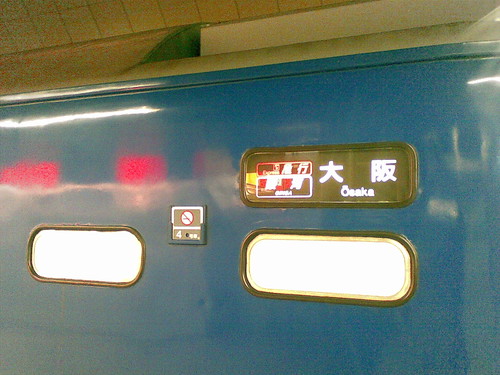
The feeling of nostalgia extends to the interior, with the brass and porcelain washroom.
In standard class the beds are small but adequate, and laid out four to a bay. The curtain provides the only privacy. Night trains are definitely a relic of a time that was less concerned about safety.
The beds come with neatly folded bedding and a yukata robe. There are "indoor slippers" to be worn around the train too. 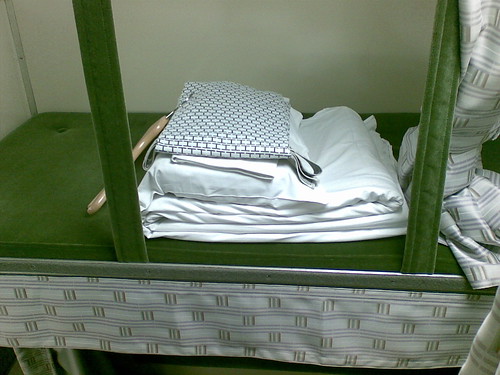
I fastened my curtains, changed into my robe, put in the iPod headphones and fell fast asleep by midnight. When I woke, the sun was rising and we were speeding through the outskirts of Kyoto. There's something very romantic about night trains.
Posted by
Auntie Em
at
2:51 AM
2
comments
![]()
Labels: Japan Exchange, oba em no tabi
Monday, October 08, 2007
On the rails
I've been travelling this weekend. It started with a Shinkansen to Tokyo, where I wandered for hours just getting as lost as possible. The Imperial Palace Gardens and a couple of parks form oases of tranquility, but otherwise Tokyo is a fairly hectic place. However the politeness and good manners of the people there make it much easier to cope with than some other cities of lesser size (I'm looking in your directions, Paris and London!)
The biggest excitement for me was actually leaving Tokyo - I caught the Ginga sleeper. I adore sleeper trains and, whilst it wasn't quite as comfortable as the capsule hotel, my little bunk/tent combo was very conducive to sleep. Waking up just after sunrise whilst travelling though the outskirts of Kyoto was fantastic - seeing the streets empty of cars and the station platforms all but deserted (apart for a few hardy Japanese trainspotters for whom a photo of the Ginga is much prized).
My colleague and friend Larissa and her daughter have been looking after me this weekend. They arrived in Osaka very late on Friday night, so my arrival at the crack of dawn on Saturday wasn't particularly well timed from their point of view! Nevertheless they've been the souls of hospitality. Larissa lived in Osaka for three years and her knowledge is invaluable - I've had to make hardly any effort at all - just follow where I'm led and some astonishing temples or heartbreakingly beautiful gardens or beautiful food is there in front of me.
Photos and videos will follow in a couple of days, with some more details about the temples and shrines that we've seen. I think I may be in love with Japan...
Posted by
Auntie Em
at
12:30 PM
0
comments
![]()
Labels: Japan Exchange, oba em no tabi
Wednesday, October 03, 2007
Around Asakusa and Ueno
Tokyo, days one and two - now with moving pictures.

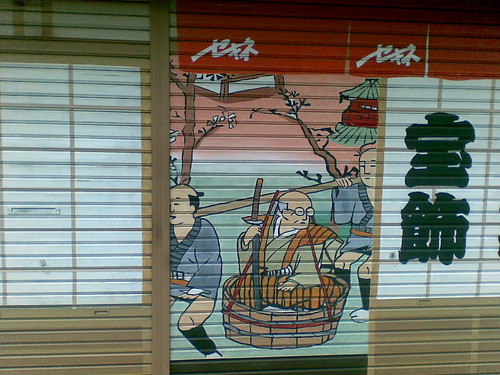
Sunday morning shuttered shops in Asakusa. I'm guessing that vandalism isn't a major problem here.
Rough and ready video of the first couple of days. Best with sound:
Posted by
Auntie Em
at
5:48 PM
0
comments
![]()
Labels: Japan Exchange, oba em no tabi
Why I'm bad for my husband's health
Interesting study on health effects, as reported in MindHacks. I haven't read the full article, as it's behind a Paywall (for anyone with generous Athens access, it's can be found via PubMed) and it may well be an example of Texas Bullseye[1], but the abstract reports that:
After adjusting for age, systolic blood pressure, body mass index, cigarette smoking, diabetes, and total cholesterol/high density cholesterol, the married men compared with unmarried men were almost half as likely to die during follow-up (hazard ratio (HR) = 0.54; 95% confidence interval (CI): 0.34-0.83)... Men with wives who were upset by work were 2.7 times more likely to develop CHD (HR = 2.71; 95% CI: 1.22-6.03).
Hmm. C'mon funding propsal!
[1]The practice of shooting up a barn door with an automatic weapon, drawing a circle round the three closest hits and calling that the bullseye, post-hoc.
Posted by
Auntie Em
at
2:11 AM
0
comments
![]()
Labels: Careers, Home front, Science
Tuesday, October 02, 2007
Shinshoji Temple, Tokyo
The Shinshoji temple is in Asakusa, so I couldn't leave Tokyo without a visit:
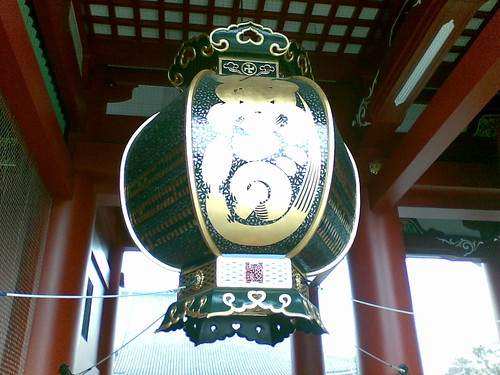
The temple gate.
Worshipers purify themselves in incense smoke before entering the temple.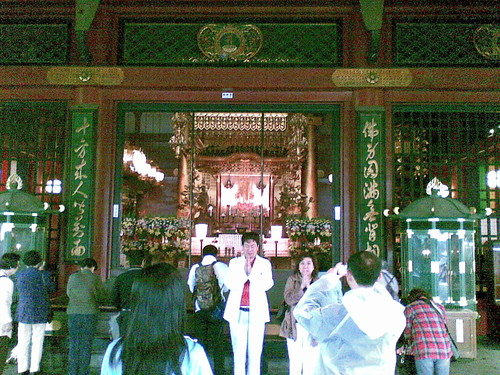
Worshipers complete their devotions by clapping very loudly..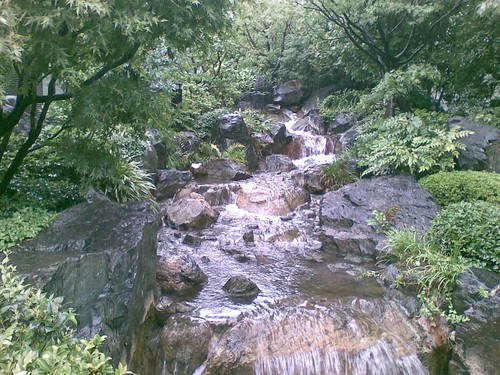
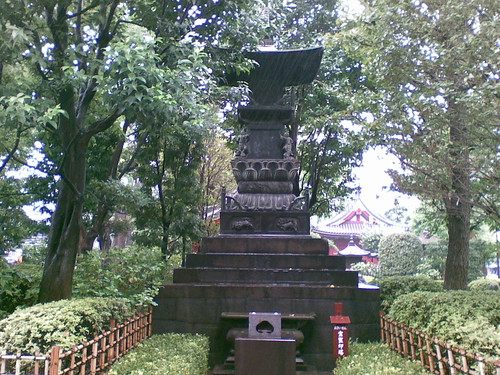

Shinshoji is surrounded by beautiful gardens, shrines and statuary.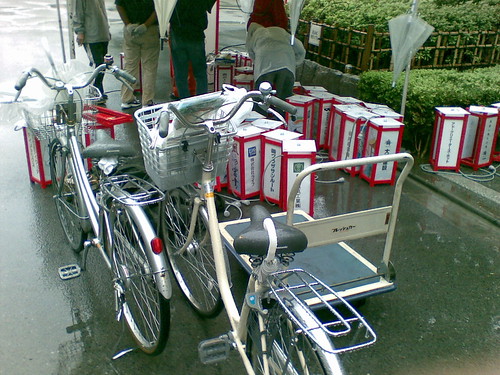
But maintaining them can't be cheap. These new lanterns are sponsored by, and carry the logo of a credit card company.
Posted by
Auntie Em
at
6:31 AM
0
comments
![]()
Labels: Japan Exchange, oba em no tabi
Monday, October 01, 2007
Capuseru Hoteru Asukasa
(Or, カプセルホテル、浅草, if you have Japanese fonts installed!)
Thanks to an excellent bilingual map of Tokyo[1] I knew exactly where to find the capsule hotel, and even which exit to leave Asakusa metro station. Check in was a little more difficult - I'm not used to having to go to a vending machine to pay for my night's stay (I swear to you - an actual vending machine that actually vends an actual ticket that you actually take to the receptionist to exchange for a locker key).
I didn't go out much the first night - I mainly walked around Asakusa, trying to position myself so that David could find me on the webcam:
[Webcam on the cheap - I'm the orange splodge by the phone box!]
By 10 o clock I was attempting my first Japanese bath, and my word was it hot. 40 degrees C sounds quite warm, a few degrees above body temperature but copeable with. Until you try it for the first time. I didn't get in any further than my knees. I've jumped in post-sauna, ice-cold plunge pools with greater alacrity than this, and I don't particularly like the cold. To every lobster I've ever eaten - I'm sorry.
The panoramic baths were only available to men. For some reason, the women's bathing arrangement's didn't involve huge floor to ceiling windows :) There was a common balcony where tea and coffee were available. It made a nice perch to watch the city from.
The heat and journey by this point were enough to make me feel like some capsule time was in order. And that's why you're here, right - to see photos of those crazy capsules. Well wait no longer dear reader: The women's floor bathroom. I may be wrong but I'm assuming the chaps don't get flowers and a hairdryer.
The women's floor bathroom. I may be wrong but I'm assuming the chaps don't get flowers and a hairdryer. Women are assigned a single floor of the nine storey hotel. Not many capsule hotels cater for women at all, as they exist mainly for the convenience of salarymen who've missed the last train home after a night on the sake. Apparently they aren't great company.
Women are assigned a single floor of the nine storey hotel. Not many capsule hotels cater for women at all, as they exist mainly for the convenience of salarymen who've missed the last train home after a night on the sake. Apparently they aren't great company.
On Saturday night, the women's floor was camaraderie personified. Japanese grandmothers visiting grandchildren whose apartments are too small to take guests and lone female travelers sharing stashes of sweets and being sweetly considerate about noise.
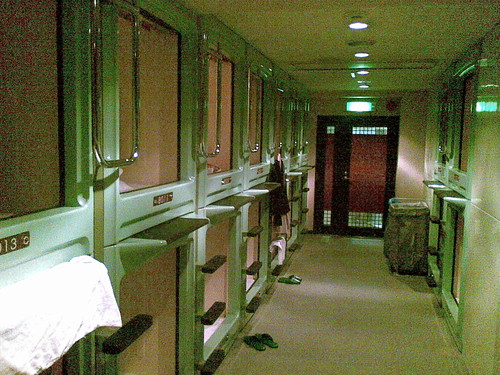 The capsules themselves were somewhat hivelike. I do think this is what the first spaceships to colonise other planets will look like. I've always thought that the living conditions on Red Dwarf were much more plausible than the ones on the Enterprise.
The capsules themselves were somewhat hivelike. I do think this is what the first spaceships to colonise other planets will look like. I've always thought that the living conditions on Red Dwarf were much more plausible than the ones on the Enterprise.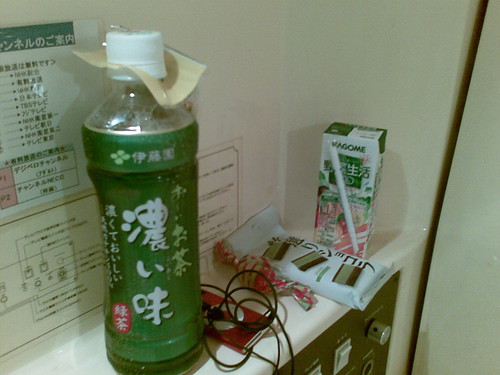
The capsule interior feels surprisingly spacious - there was room to sit and read, and to watch some Simpsons on the laptop. The radio unit doubles as a handy shelf and the dimmable light makes things very cosy indeed. Nothing about the experience felt in any way strange, and the capsule was easily big enough for someone of my height (5'10"). I've never slept so well on my first night anywhere.
The photos of the inside of the capsule don't do it any justice, but I have some video coming up that will show you a capsule in all its glory. I'm off to explore Sendai.
[1] Tokyo City Atlas: A Bilingual Guide, Kidansha International, 2004. ISBN-13: 978-4-7700-2503-6. I got mine from Stanfords.
Posted by
Auntie Em
at
12:41 AM
0
comments
![]()
Labels: Japan Exchange, oba em no tabi

